Quadriceps Muscle Pain
What is a Quadriceps Muscle Pain?
Quadriceps muscle pain can arise from a variety of causes, including overuse, strain, direct trauma, muscle imbalances, and underlying medical conditions. Athletes, particularly those involved in sports that require repetitive leg movements or sudden changes in direction, are especially prone to quadriceps muscle injuries.
Additionally, individuals who engage in activities that place excessive strain on the quadriceps, such as weightlifting or prolonged sitting, may also experience discomfort or pain in this muscle group.
Introduction
The quadriceps refers to the four muscles located on the front of the thigh. This muscular group makes up the bulk of the anterior thigh and is vital for extending the knee, such as walking, running, jumping, squatting, and climbing stairs.
Anatomy of the Quadriceps
The quadriceps consists of four separate muscles:
- Rectus Femoris – Runs down the middle of the thigh. Originates from the ilium and the rim of the acetabulum. It inserts into the patella via the quadriceps tendon.
- Vastus Lateralis – Runs down the outer part of the thigh. Originates from the greater trochanter and upper femur and inserts into the patella via the quadriceps tendon. It is the largest and most superficial of the quadriceps muscles.
- Vastus Medialis – Covers the inner, middle portion of the thigh. Originates from the lower end of the intertrochanteric line and the upper third of the medial supracondylar line. Inserts into the quadriceps tendon. An important muscle for knee stabilization.
- Vastus Intermedius – Located between the vastus lateralis and vastus medialis, underneath the rectus femoris. Originates from the upper 2/3 of the anterior and lateral femoral shaft. Insertion at quadriceps tendon and tibial tuberosity.
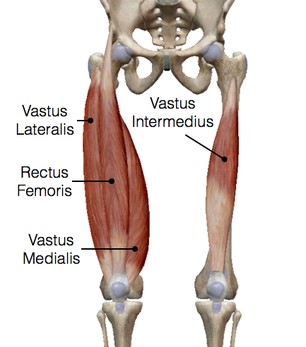
Blood Supply and Nerve Supply
The quadriceps has an extensive blood supply from small arteries that run through the muscles. The rich vascular network provides oxygen and nutrients as well as removes metabolic waste.
The quadriceps are innervated by the femoral nerve, which originates in the lumbar and sacral spine. This large nerve conducts signals from the central nervous system to direct motor activity of the quadriceps muscles.
Function and Role
As the primary extensors of the knee, the quads enable activities like walking, running, squatting, jumping, and climbing. Eccentric contractions of the quads, which lengthen the muscle while under tension, act as shock absorbers that stabilize the knee joint during walking and running gaits.
The quadriceps also plays an important role in supporting the patella and protecting against patellofemoral pain. In particular, the vastus medialis obliquus (VMO) contributes to proper patellar tracking during knee flexion and extension.
Causes of Quadriceps Pain
Contusions
A contusion occurs when a significant direct blow or trauma impacts the quadriceps muscle, often during sports or a fall. This crushes the muscle fibers and blood vessels, triggering internal bleeding (hematoma) within the surrounding tissue. The rectus femoris is most vulnerable as it lies closest to the surface.
As blood accumulates, swelling and inflammation press on nerve fibers, provoking pain. Discoloration also emerges within 1-2 days as hemoglobin breaks down. The injured area feels stiff, tender, and achy, especially when walking, contracting the quad, or palpating the thigh. Full recovery varies from 10 days up to 6 weeks depending on contusion size. Proper treatment involves rest, ice, compression, and keeping the leg elevated.
Compartment Syndrome
Compartment syndrome specifically refers to excessive internal bleeding and swelling between the thigh’s muscular compartments, comprised of fascia and membranes. As blood rapidly accumulates, pressure builds, compressing muscles and vessels.
This impedes venous return as well as arterial blood flow. Lack of oxygen causes muscle and nerve tissue to break down within hours, resulting in permanent damage if not urgently addressed. Myoglobin and potassium leakage can also lead to kidney failure.
Emergent fasciotomy surgery releases pressure by cutting the fascia sheath. This prevents muscular necrosis while allowing drainage and vascular restoration. Strict monitoring of compartment pressure is essential both pre and post-op. Significant rehabilitation enables patients to regain quad strength and function.
Muscle Strain Injuries
Acute strains are categorized into 3 graded levels of severity.
- Grade 1 strains over-lengthen muscle tissues without tearing. Discomfort occurs during contraction but strength remains intact. Conservative treatment allows strains to heal within ~2 weeks.
- Grade 2 denotes partially torn muscle fibers with localized weakness, swelling, and functional loss. Healing takes ~4-8 weeks with proper rehab.
- Grade 3 strains are complete muscle tears or ruptures, fully disabling knee extension. These require surgical intervention to suture the ends of the detached tissues before a prolonged, progressive rehab regimen.
All strains increase susceptibility to future re-injury without careful prevention strategies.
Chronic Quadriceps Tendon Issues
Repetitive strain from overuse leads to painful inflammation of the patellar or quadriceps tendons, termed tendinitis. Microtearing provokes swelling, irritation, and warmth around the tendons. Activities involving repetitive jumping place substantial shear stress on these tissues.
Additionally, long-term tendon wear and tear causes tendinosis or degeneration. This manifests as anterior knee aches, stiffness after rest, and loss of flexibility. Custom strengthening and flexibility programs aim to rehabilitate damaged tendons. Platelet-rich plasma or stem cell injections may also reduce inflammation. Surgical debridement remains an option for recalcitrant cases.
Ruptured Tendons
Sudden, forceful quad contraction against resistance can cause a complete rupture of the patellar or quadriceps tendon. This frequently follows a fall with the foot planted as hands grasp the thigh in an attempt to break the landing. A palpable defect remains at the tear site.
Without operative repair, knee extension remains permanently disabled. Surgery tightly sutures the torn ends, allowing protected loading followed by gradual rehabilitation. Excellent outcomes occur with an anatomical repair before retraction and scarring. Timely repair enables athletes to eventually return to sports after full recuperation of strength and flexibility.
Signs and Symptoms of Quadriceps Muscle Pain
Pain
- Aching, sore, or sharp pain in the front of the thigh that worsens with activity and eases with rest. Pain levels range from minor to severe.
- May have a throbbing pain or “charley horse” sensation. Pain typically centers around the area of injury.
- Pain when walking, especially downstairs or on inclines
- Pain when straightening knee against resistance from a seated position
Swelling & Bruising
- Swelling, puffiness, and bruising can occur, especially with contusions or strains. Indicates bleeding and inflammation in tissues.
- Bruising may emerge as a reddish, purplish, or black-and-blue discoloration of skin.
Muscle Weakness
- Difficulty fully straightening the knee or bearing weight on the leg
- Noticeable loss of strength when attempting to contract quadriceps muscle
Joint Stiffness
- Sensation of thigh muscle tightness or tension
- Stiffness after sitting or inactivity that eases with movement
Tenderness
- Exquisite tenderness when palpating the quadriceps muscle and tendons
- Pain when the knee is bent against resistance in a seated position
Difficulty Using Limb
- Antalgic gait (limping), altered biomechanics when walking
- Avoiding stairs, squatting position
- Modifying or avoiding exercise/sports activities
Popping or Tearing Sensation
- A pop or snap at the time of traumatic injury indicates a potential tear
Risk factors
Sports Overuse
- Sports involving sprinting, jumping, and rapid changes in speed increase strain on quads – basketball, volleyball, soccer, tennis, track and field events
Training Errors
- Inadequate strength and flexibility training
- Overtraining and insufficient rest between intense workouts
- High training mileage too rapidly when running
Muscular Imbalances
- Tight hip flexors and hamstrings put extra demand on the quadriceps
- Weak glutes unable to assist properly with hip extension
Poor Movement Patterns
- Faulty running, jumping biomechanics
- Allowing knees to collapse inwards during athletic maneuvers
Prior Knee Injury
- ACL tears or meniscal injuries altering mechanics, quad inhibition
- Patellofemoral syndrome causing extra patellar tendon strain
Trauma
- Falls, collisions, or contusions directly damage quad muscle tissues
Age
- Patellar tendinopathy is more likely over age 40
- Reduced tissue elasticity with aging
Other Factors
- Being overweight or obese
- Vitamin/mineral deficiencies
- Autoimmune disorders
- Metabolic issues like diabetes
The most preventable risks involve improper strength training, overuse, and faulty movement
Diagnosis
Diagnosing the underlying cause of anterior thigh pain requires a systematic approach comprising a detailed history, physical examination, appropriate imaging, and potential bloodwork. This enables proper treatment selection and guides rehabilitation plans.
History
The practitioner obtains a focused history assessing:
- Pain location, quality, severity, duration
- Inciting injury or overuse
- Difficulty ascending/descending stairs
- Sports participation
- Other medical factors
Physical Examination
Thorough evaluation includes:
- Palpation for tenderness and swelling
- Passive/active range of motion testing
- Manual muscle testing of quadriceps
- Assessing gait pattern
- Special tests (e.g. patellar grind)
Imaging Studies
- X-rays check for fractures and calcific tendinosis
- MRI visualizes soft tissue injuries like intramuscular hematomas, strains/tears
- Ultrasound evaluates quadriceps/patellar tendon integrity
Treatment Plan for Quadriceps Muscle Pain
Acute Phase
Initially following a quadriceps contusion, strain, or tendon injury, treatment focuses on the R.I.C.E. protocol – Rest, Ice, Compression, Elevation:
- Strict rest from athletic activities that aggravate pain
- Ice for 20 mins every 2-3 hours to decrease inflammation
- Elastic wrap compresses and supports the thigh
- Keep the leg elevated above heart level to limit swelling
Medications
- Oral NSAIDs (ibuprofen, naproxen) alleviate discomfort and inflammation
- Acetaminophen used for milder quadriceps strains
- Topical anti-inflammatories ease tendonitis symptoms
- Cortisone or PRP injections can treat chronic tendinopathy
Rehabilitation Exercises
Under the guidance of a physical therapist, exercises commence once initial pain diminishes:
- Gentle range of motion movements
- Progressive strengthening program (isometrics → concentric → eccentrics)
- Stretching tight hip flexors, quadriceps, IT band, and calves
- Patellar mobilizations if patellar tendon involvement
- Aquatic training beneficial during recovery
Surgery
- Severe Grade 3 muscle strain tears or complete quad/patellar tendon rupture require surgical repair followed by extensive rehabilitation. This may involve graft reinforcement or tissue debridement along with tight suturing of torn fiber ends.
Physiotherapy Treatment Options
Heat Therapy:
Applying heat to the affected area can help relax the muscles and relieve pain. Heat packs or warm towels can be used for this purpose. It is important to be cautious while using heat therapy to avoid burns or excessive heating.
Cold Therapy:
Cold therapy, also known as cryotherapy, can assist in reducing inflammation and swelling. Ice packs or cold compresses should be applied to the affected area for 15 to 20 minutes several times a day. However, precautions must be taken to prevent frostbite, such as wrapping the cold pack in a towel before applying it to the skin.
Massage:
Massage therapy can be beneficial in relieving muscle tension and promoting blood circulation in the quadriceps. A certified physiotherapist can apply various techniques, such as deep tissue massage or trigger point massage, to address specific areas of discomfort.
Ultrasound Therapy:
This type of therapy involves the use of high-frequency sound waves to penetrate deep into the tissues, promoting healing and reducing pain. During an ultrasound session, a gel is applied to the skin, and a specialized device is used to emit the sound waves.
Stretching
Lunging Hip Flexor Stretch
The lunging hip flexor stretch lengthens tight hip flexors, which often contribute to excessive quadriceps tightness and anterior knee pain.

- Stand in a staggered stance, one leg forward and one leg back
- Keep the torso upright, and engage core muscles to avoid excessive arching of the lower back
- Shift hips forward until a mild stretch sensation is felt on the front of the rear leg
- Hold this gentle stretch for 30 seconds
- Repeat 2-3 times on each leg
This targets the iliopsoas muscle as well as the connecting fascia bands surrounding the thigh. Stretching should produce mild tension, not pain which could indicate tissue damage.
Standing Quadriceps Stretch

The standing quad stretch isolates the rectus femoris muscle and vastus group of the quadriceps.
- Balance near a wall with one hand, bending the knee to grasp the ankle
- Gently pull the heel toward the gluteal muscles until a mild stretch is felt along the front of the thigh
- Avoid bouncing or overstretching which could worsen muscle strains
- Maintain for half a minute, let go, and repeat one or two times.
For rehealing strains, keep the stretch knee slightly bent to avoid placing excessive tension on healing muscle fibers. This facilitates mobility without impeding the regeneration process.
Regular, gentle stretches can help maintain flexibility and hasten recovery from many types of quadriceps muscle pain. Always monitor pain levels and adjust position accordingly.
Exercises to Strength Quadriceps Muscle
Static Quadriceps Exercise (SQE):
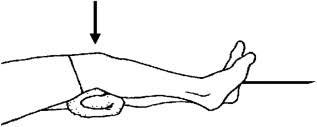
- Sit with knees bent at 90 degrees, feet flat
- Tighten quad muscle, push back of the knee down
- Extend knee fully, hold for 5 secs
- Feel tension building in front thigh
- Relax muscle after, and allow the knee to bend
- Repeat 10 reps, rest between sets
- Complete 2-3 sets of 10 reps
- Progress by adding a resistance band
- Perform 2-3x daily in early rehab stages
- Builds initial quad strength safely
Vastus medialis oblique or VMO:

- Sit with the involved knee bent at 90 degrees
- Place a ball/rolled towel under the knee
- Straighten knee, pressing back of knee into ball
- Angling knee inwards targets VMO
- Hold contraction for 5 seconds
- Feel the deep burn in the inner thigh
- Return to starting position
- Complete 10-15 repetitions
- Rest; Repeat for 2-3 sets
- Progress by adding ankle weights
Wall Squats:
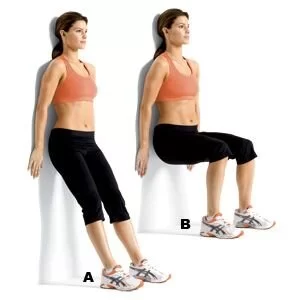
- Place your back to the wall and place your feet shoulder-width apart.
- With your knees bent at a ninety-degree angle, slide down the wall.
- Hold squat position 5-30 seconds
- Engage the core, keep hips level and weight in heels
- Push back up the wall to standing
- Repeat 10 times, 2-3 sets
Partial squats:

- Stand with feet wider than hip distance
- Initiate squat by pushing hips back
- Descend halfway down, stop above the parallel
- Push through heels back to start position
- Keep knees tracking over toes
- Repeat 10 times, 2-3 sets
Knee to Chest:

- Lie on your back, bend one knee up to the chest
- Grasp thigh under the knee cap
- Gently pull the knee closer to the torso
- Feel stretch in front of the thigh
- Hold for 30 seconds
- Relax your leg back down
- Repeat 2-3 times each leg
Strategies to help prevent quadriceps muscle pain and injuries:
Warm Up and Cool Down
- Always warm up properly before exercise—light walking/jogging and quadriceps muscle stretch gently prepare the tissues.
- Cooling down with low-intensity movements stimulates circulation to remove lactic acid and waste buildup that can result in soreness.
Train at Appropriate Intensity and Frequency
- Avoid aggressive training spikes in exertion level or duration, which enable cumulative fatigue to catch up, raising injury likelihood and overuse syndromes.
- Sufficient rest between workout days maintains recovery ability and prevents tissue overload and breakdown.
Incorporate Flexibility and Strengthening Exercises
- Stretch quadriceps, hip flexors, and calves to preserve muscle length and extensibility needed for transferring forces.
- Strengthen muscle groups with exercise variations to distribute joint loads rather than overburdening one section.
Support Proper Biomechanics
- Use orthotics/insoles to fix overpronation issues, and alignment abnormalities placing extra load on the quads.
- Review and correct posture, running, or squatting form. Improper mechanics increases strain on the knee extensors.
Wear Proper Equipment
- Ensure footwear fits and provides enough stability and cushioning. Replace athletic shoes every 300-400 miles.
- Knee braces are sometimes recommended with anterior thigh tendinopathies and patellofemoral disorders to improve patellar tracking and offload forces.
Periodical Checkups
- Evaluate muscle flexibility, strength, endurance, and imbalances with athletic trainers/sports medicine professionals—correct any deficits or weaknesses through targeted exercises. Monitor areas susceptible to overuse.
By implementing a multifaceted injury prevention program focused on preserving tissue integrity on a structural, biomechanical, and physiological level, quadriceps discomfort can be avoided even with intense training regimens.
Summary
The quadriceps muscle group, located on the anterior thigh, is vital for extending the knee and allows functions like walking, running, and jumping. This large muscle complex is comprised of the rectus femoris, vastus lateralis, vastus medialis, and vastus intermedius. Quadriceps strains and tears comprise a common sports-related injury and source of debilitating pain and weakness. Multiple conditions can provoke acute discomfort or chronic issues over time.
Various mechanisms contribute to quadriceps pathology including contusions from direct trauma, compartment syndrome from internal bleeding, or skeletal strains categorized into grades 1-3. Tendon inflammation from repetitive strain as well as patellofemoral syndromes also irritate structures causing thigh pain. Key symptoms center around knee joint stiffness, difficulty bearing weight, noticeable limping, swelling/bruising, tenderness upon palpation, and outpouring of strength with attempted muscle contraction. Pain typically worsens with activity and eases somewhat with rest.
Diagnosis involves a detailed history assessing pain characteristics, functional deficits, and inciting events. Targeted physical examination tests range of motion, and strength, palpates for swelling, and assesses biomechanics. Diagnostic imaging like ultrasound and MRI visualizes soft tissue structures. Initial treatment focuses on RICE principles (rest, ice, compression, and elevation) along with pain-modulating medications. A gentle range of motion can progress to strengthening once acute inflammation subsides. Surgery may repair severe muscle or tendon tears before rehabilitation.
Long-term, properly warming up and cooling down, allowing adequate recovery between intense activity bouts, maintaining muscle flexibility and strength, and practicing proper biomechanics during sports protect the quadriceps complex. Inflammation control combined with physical rehabilitation aims to relieve discomfort, heal injured structures, restore normal movement patterns, maximize strength gains, and reduce the likelihood of recurrence.
FAQs
What are the most common causes of quadriceps pain?
The most common causes are strains from overuse or sports injuries, contusions from blows/trauma, tendon inflammation from repetitive strain, quadriceps tendon tears, and patellofemoral pain syndrome irritating the knee joint.
What symptoms may occur with quadriceps pain?
Common symptoms include anterior knee pain that worsens with activity, thigh swelling, bruising, tenderness when touching the thigh, difficulty straightening the knee, stiffness after rest, limping, or weakness when trying to contract the quad muscle.
How is quadriceps pain diagnosed?
Diagnosis involves assessing medical history, physical exam testing for pain, weakness, and reduced range of motion, imaging like x-ray or MRI to see soft tissue structures, and lab tests checking enzymes like CPK for muscle damage.
How can I treat and manage pain from a quadriceps strain?
Early treatment centers on the RICE methodology – rest, ice packs, compression bandages, and keeping the leg elevated. Once the swelling has diminished, gentle stretches, strengthening exercises, anti-inflammatory medications, taping, and physical therapy can help rehab the injury.
What can I do to help prevent future quadriceps pain?
Prevention strategies involve properly warming up and cooling down, allowing adequate rest between vigorous workouts, maintaining quad flexibility through stretching, strengthening thighs and glutes with exercises, wearing proper protective gear during sports, and avoiding overtraining injury-prone muscles.
References
Ladva, V. (2022, March 8). Quadriceps muscle pain: Cause, Symptoms, Treatment, Exercise | Mobile. Samarpan Physiotherapy Clinic. https://samarpanphysioclinic.com/quadriceps-muscle-pain/#Exercise_for_the_quadriceps_pain
Freutel, N. (2023, May 30). Pulled Quad: How to Treat It and Bounce Back Quickly. Healthline. https://www.healthline.com/health/fitness-exercise/pulled-quad-treatment
Pt, B. S. (2023, June 5). The Anatomy of the Quadriceps Muscles. Verywell Health. https://www.verywellhealth.com/what-are-the-quadriceps-muscles-2696379
Quadriceps Muscle Strain. (n.d.). Physiopedia. https://www.physio-pedia.com/Quadriceps_Muscle_Strain




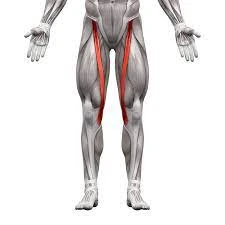

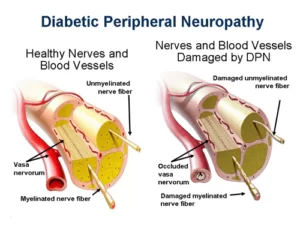

2 Comments